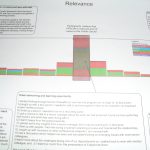 Recently I was discussing the issue of narrative research at the KM Asia Conference in Singapore. Some years ago I was engaged in using the technique, albeit in a very raw form when I was evaluating a program I was managing for Victoria Police. The richness of the anecdotes and the emergence of issues were very powerful and provided a clear hook for people’s understanding of what we were doing.
Recently I was discussing the issue of narrative research at the KM Asia Conference in Singapore. Some years ago I was engaged in using the technique, albeit in a very raw form when I was evaluating a program I was managing for Victoria Police. The richness of the anecdotes and the emergence of issues were very powerful and provided a clear hook for people’s understanding of what we were doing.
In a later role a similar technique was used in evaluating the ROI on a senior leadership program. The whole issue of looking at ROI for such a program caused a great deal of thinking and struggling with what might be the best way to do it as one cannot simply turn out leadership widgets at the conclusion of the program. In this instance I used a technique more aligned with the work undertaken by Brinkenhoff but in a modified format. This again proved to be useful and captured the richness of experience as well as the impact for people. It was also a method by which we could continue to capture the impact over time and develop a rich knowledge repository.
In later times I have applied the methodology developed by Cognitive Edge by using Sensemaker. In this particular instance we needed an innovative method of evaluating and capturing the impact of a statewide innovation network that was funded by the Victoria Public Service. Sensemaker provided the tool that allowed us to capture narrative , make sense of the anecdotes and look at emergent trends. I have uploaded a copy for those who are interested VPSCINevaluation2
I am currently collaborating with some colleagues in developing other pieces of narrative research using Sensemaker and anecdotes. Some of this is anticipated to be quite ground breaking and I hope that I am able to share details on this blog in the not too distant future.
